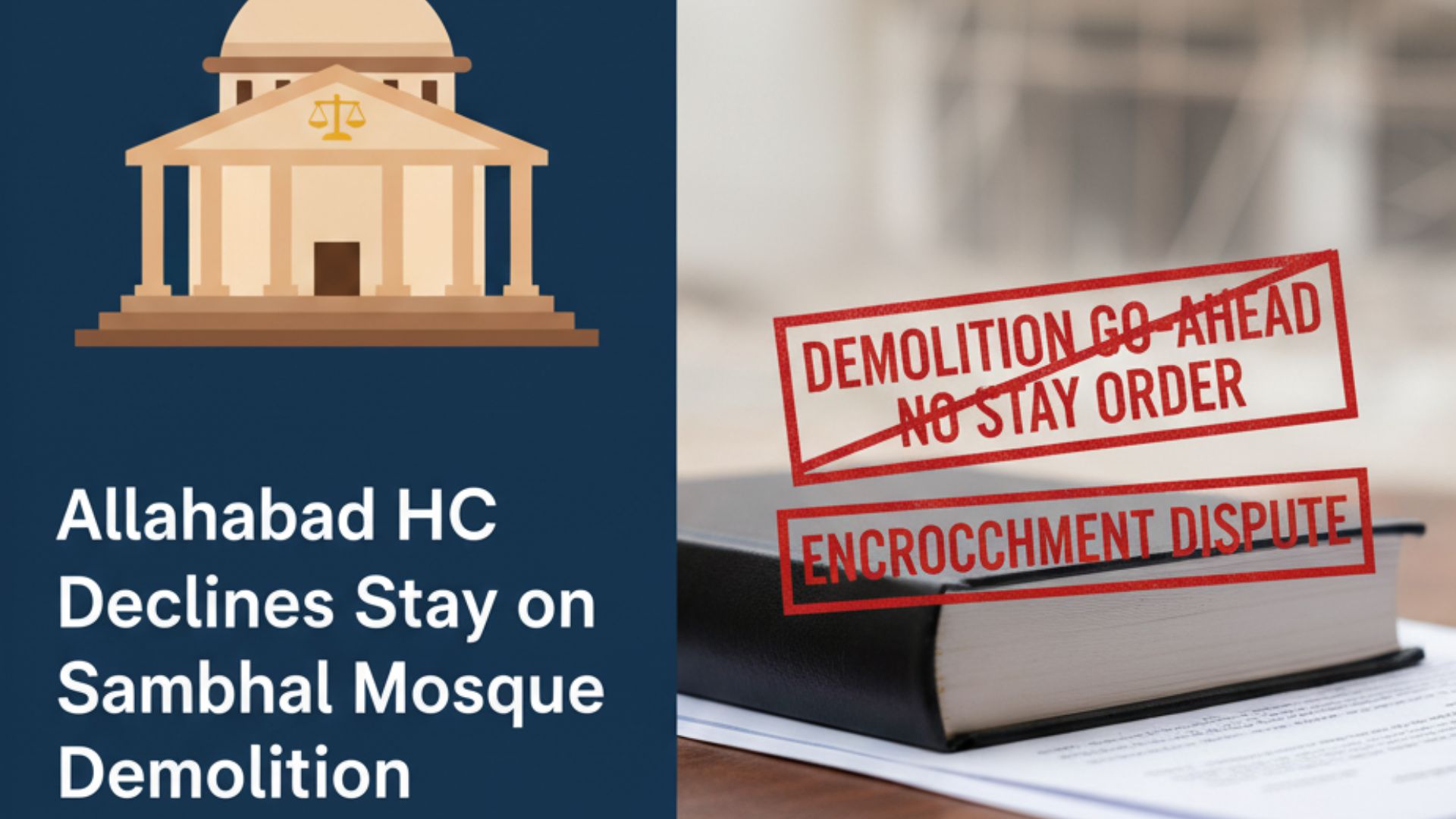 Allahabad High Court Refuses to Halt Sambhal Mosque Demolition: Encroachment or Religious Dispute?
Allahabad High Court Refuses to Halt Sambhal Mosque Demolition: Encroachment or Religious Dispute?
Court dismisses plea, says mosque committee must approach trial court for relief
Demolition on Gandhi Jayanti sparks controversy; administration cites illegal construction on pond land
By Our Legal Correspondent
New Delhi: October 04, 2025:
The Allahabad High Court has refused to stay the demolition of a mosque, marriage hall, and hospital in Sambhal district, Uttar Pradesh, ruling that the structures were allegedly built on government land. The decision, delivered on October 4, 2025, by Justice Dinesh Pathak, dismissed a petition filed by the mosque committee and directed them to seek remedy before the trial court.
The case has triggered widespread debate, with the demolition coinciding with Gandhi Jayanti and Dussehra, raising concerns about timing, law and order, and the balance between religious rights and land ownership laws.
Background of the Case
The controversy centers on the Masjid Sharif Gausul Wara Rawa Buzurg in Raya Buzurg village, Sambhal district. Alongside the mosque, a 30,000 sq. ft. marriage hall and a small hospital were also demolished.
- The mosque was reportedly built around 2009–2010.
- Authorities claimed that the mosque and adjoining structures were illegal encroachments on land classified as a pond in government records.
- The mosque committee, led by its mutawalli (caretaker) Minjar Hussain, argued that the structures were built with community contributions and had been in use for over a decade.
The demolition drive was carried out under heavy police deployment to prevent unrest.
The Petition and Court Proceedings
The mosque committee filed a petition in the Allahabad High Court, challenging the demolition. Their main arguments were:
- The demolition began without a formal order, violating due process.
- The September 2, 2025 demolition order was never properly served on them.
- The demolition was deliberately scheduled on October 2 (Gandhi Jayanti and Dussehra), when large gatherings could have led to communal tension or riots.
- The committee had already begun voluntarily dismantling the portion of the mosque that allegedly encroached on government land.
The administration, however, maintained that:
- The mosque and marriage hall were illegal constructions.
- The marriage hall was built on land that was originally a pond, causing waterlogging in the village.
- The mosque partially stood on government land, making it unlawful.
- The demolition order was passed after hearing all parties, and no appeal was filed against it.
After hearing both sides, Justice Dinesh Pathak dismissed the petition, stating that the mosque committee should approach the trial court for further relief.
The Demolition Drive
On October 2, 2025, bulldozers arrived at the site under the supervision of District Magistrate Dr. Rajendra Pensiya and senior police officials.
- The marriage hall was razed first.
- The mosque’s outer wall was partially demolished, with reports suggesting that locals themselves began dismantling parts of the structure after being given four days by the administration.
- The demolition was carried out amid tight security, with villagers advised to remain indoors.
This was the second mosque-related demolition in Sambhal in four months, adding to the sensitivity of the issue.
Legal Context
The case was filed under Section 67 of the UP Revenue Code, 2006, which deals with encroachments on government land.
The High Court’s ruling emphasized:
- Courts cannot interfere in demolition orders unless there is a clear violation of law.
- Petitioners must first exhaust remedies before the trial court.
- Religious structures are not exempt from land ownership laws if built on encroached land.
This judgment aligns with previous rulings where courts have upheld the government’s right to remove encroachments, even if they involve places of worship.
Political and Social Reactions
The demolition has sparked sharp reactions across Uttar Pradesh and beyond.
- Supporters of the administration argue that illegal encroachments, regardless of religious affiliation, must be removed to uphold the rule of law.
- Critics, including some community leaders, allege that the demolition was politically motivated and could inflame communal tensions.
- Civil rights groups have raised concerns about the timing of the demolition on a national holiday, suggesting it could have been avoided to prevent unrest.
The issue has also gained traction on social media, with hashtags related to “Sambhal Mosque” trending nationwide.
Broader Context: Bulldozer Politics
The Sambhal mosque demolition is part of a larger trend often referred to as “bulldozer politics” in Uttar Pradesh, where authorities have increasingly used demolition drives against alleged illegal constructions.
- Supporters see it as a crackdown on lawlessness.
- Critics argue it is often selectively applied and disproportionately affects minority communities.
The High Court’s refusal to intervene may embolden further such actions, though each case will depend on its specific facts and legal standing.
Conclusion
The Allahabad High Court’s decision in the Sambhal mosque demolition case underscores the tension between religious rights and land ownership laws in India. While the court has upheld the administration’s authority to act against encroachments, the controversy highlights the need for sensitive handling of religious structures to prevent communal discord.
As the mosque committee prepares to approach the trial court, the case will continue to test the balance between rule of law, due process, and social harmony in one of India’s most politically charged states.
ALSO READ POPULAR ARTICLES
-
SC Quashes Rape Case on False Marriage Promise, Terms It ‘Vengeance’
-
SC: Legal Heirs Can Claim Compensation Despite Unrelated Death
-
Allahabad HC: Wife Can Claim Maintenance from Minor Husband at 18
-
Supreme Court Directs Day-to-Day Hearings in Rape and Sensitive Cases
-
SC Upholds FIR Quashing for DM Gaming in Karnataka Poker Case
-
Delhi HC Seeks Uniform Civil Code, Flags Child Marriage Law Clash
-
SC Orders Builder to Refund ₹43 Lakh + 18% Interest for Delay
-
Delhi HC Warns Against Misuse of Section 498A in Matrimonial Cases
-
Karnataka HC Rejects X Corp’s Plea Against Govt Takedown Orders